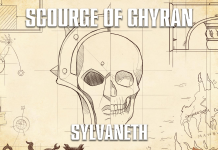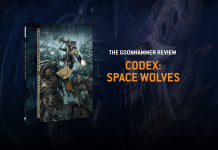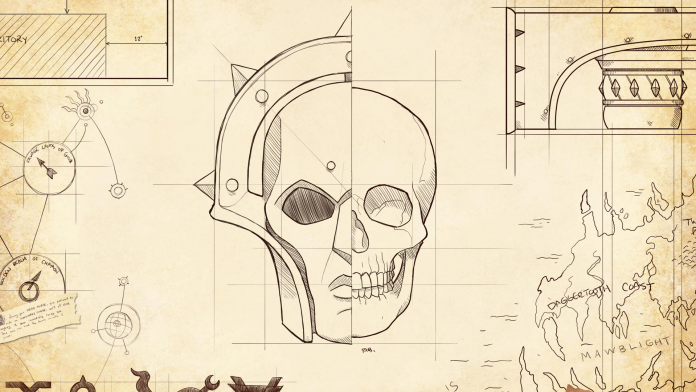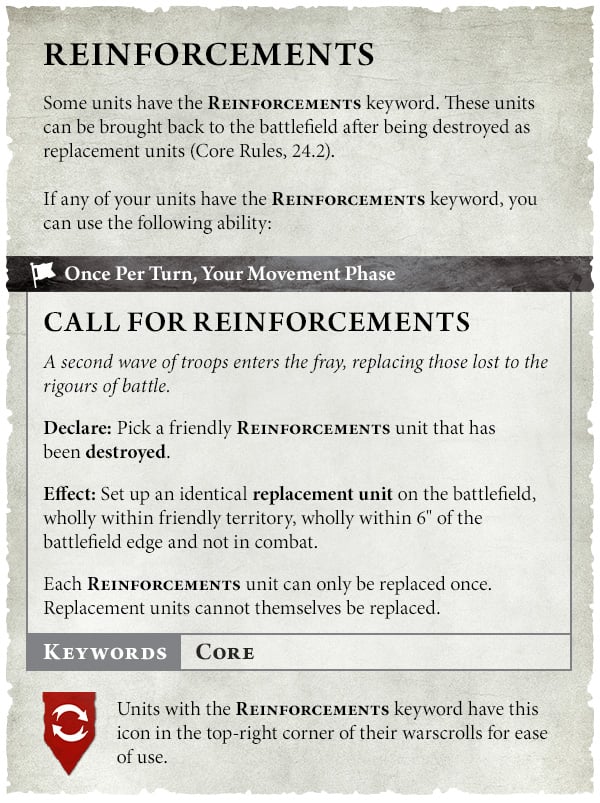At the Warhammer Open event in Dallas, Games Workshop gave the general public the first opportunity to try it’s new Spearhead format for Age of Sigmar fourth edition. Alongside the guided demos happening just outside the main gaming hall, led by members of the AoS design team, there was a Spearhead blind box event. This event came with pre-assembled Vanguard boxes for participants to keep, as well as offering a closer and more independent look at what playing the new Spearhead format would look like. Two of our Goonhammer writers, Dan “Swiftblade” Richardson and Contemptor Kevin, attended this event to try out the first attempt at organized play for the new format.
How did it go? What worked about the event, and what might need tweaking in the future? Let’s turn it over to them to find out.
Dan “Swiftblade” Richardson
When I saw the “Sig-Mystery” event at the Dallas Open, I had a very strong hunch it would be a chance to try Age of Sigmar fourth edition. The fact participants got a random blind box to play with was a dead giveaway: In AoS third edition, these boxes have no supported format to play them. Unless this “mystery” event was for some sort of unannounced game mode that directly supported games using these boxes, like Combat Patrol from 40k. Plus, the description said it wouldn’t interfere with my ability to play in the 40k GT that weekend, which I already bought a ticket for. I picked up a ticket, and waited to see if my hunch about the new game mode was correct.
God, I love being right.
A few months passed, and it was time for the big event. With a killer road trip playlist ready and Chaos Space Marines loaded up in the back of my car, I trekked up to Dallas for a weekend full of 40k and Spearhead.
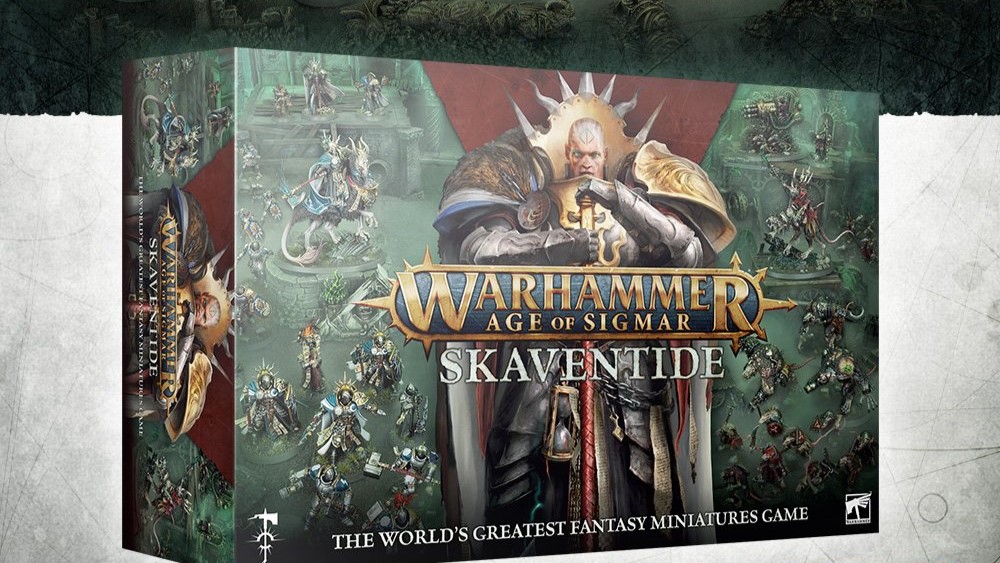
The Event
Honestly, the weekend was too full of Warhammer. It’s the main criticism I have of the event. When I signed up for the event, I figured it would happen late at night, after folks had a chance to leave, get some dinner, and come back to the venue for some extra ham slam action. After all, those dinners with friends at events are usually the highlight of the whole weekend. In reality, my schedule ended up being very tight, with the last round of 40k on Friday and Saturday ending at 8 and Spearhead scheduled to start at 8:30. There’d be no chance to leave and get food, unless I was willing to pay out the nose for venue food or I got lucky and my last round each day was a speedy blowout.
So when I got in line for the Spearhead event on Friday, I was exhausted. Especially so, since the last game that day had been a very tight one that required my smooth and tiny brain to fire on all cylinders. My feet were sore, my back was aching, and my mind was little more than mush as I stood in line for the Spearhead event. While I like the idea of these after hours events for smaller formats like Spearhead, I hope Games Workshop schedules more time between events in the future. At least give me time to eat.
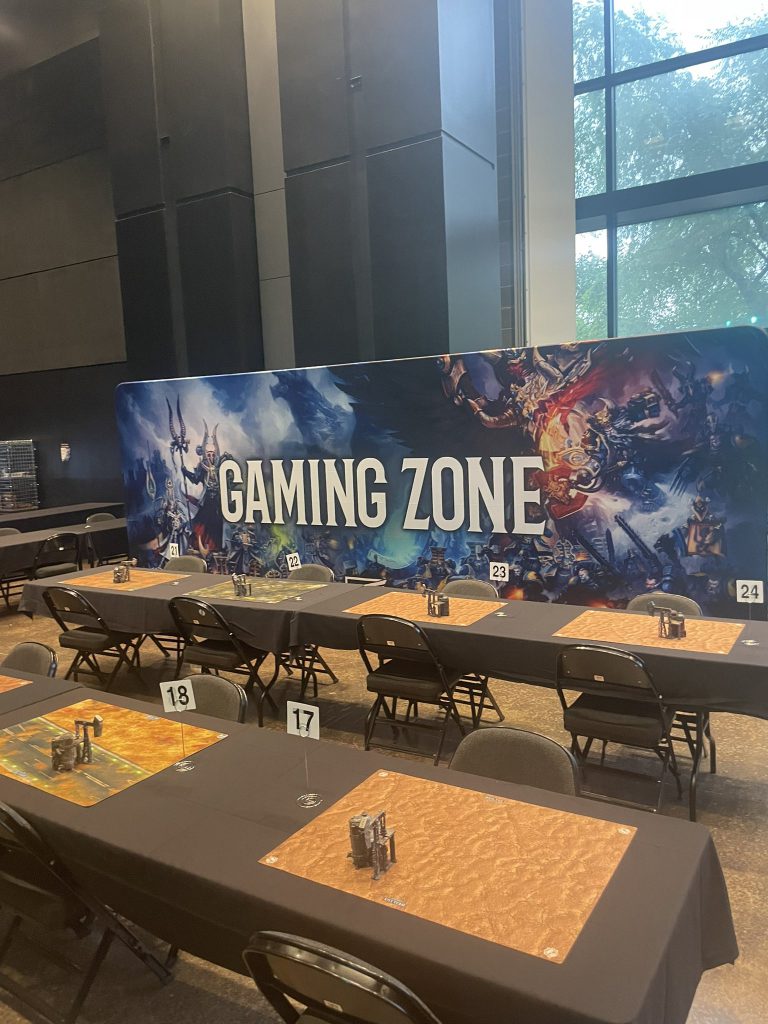
After briefly standing, and then sitting, in line, myself and the other folks who signed up were whisked away behind some dividers and given two briefs by the Games Workshop design team. First, we weren’t allowed to take pictures, period. We could either voluntarily put our phones in a box, or keep them on us. But if anyone was seen with a phone, for any reason, that person would be kicked out. The team took this very seriously. It’s very cool to be able to try out an edition early, and leaks are a surefire way to make sure that never happens again.
Second, we were given a brief rundown of some rules concepts that are unique to 4.0, like the ½ inch coherency range, taking mortals on retreat, and how wound allocation works, as well as the basics of Age of Sigmar for those more familiar with 40k. We also were given an explanation of the flow of Spearhead’s gameplay, to supplement the oversized Spearhead gameplay reference sheets at the table. Having these sheets handy was a great idea by Games Workshop, though the rules sheets only covered the faction rules for your box and basics of Spearhead. Not having a primer on the rules of AoS 4.0 was sorely missed.
We’re all then set loose to pick a spot, find out the Vanguard box we received for the event (which is ours to keep, very cool), and get to the business of playing Spearhead.
Unrest in the Forest
I got Sylvaneth, which meant my tree-pun filled Vanguard force was as follows:
- A Branchwych, “Tree Larson”
- 5 Tree Revenants, “The Troubles with the Trees”
- 3 Kurnoth Hunters with Greatbows, “The Tree Amigos”
- 1 Treelord, “Tim Treebow”
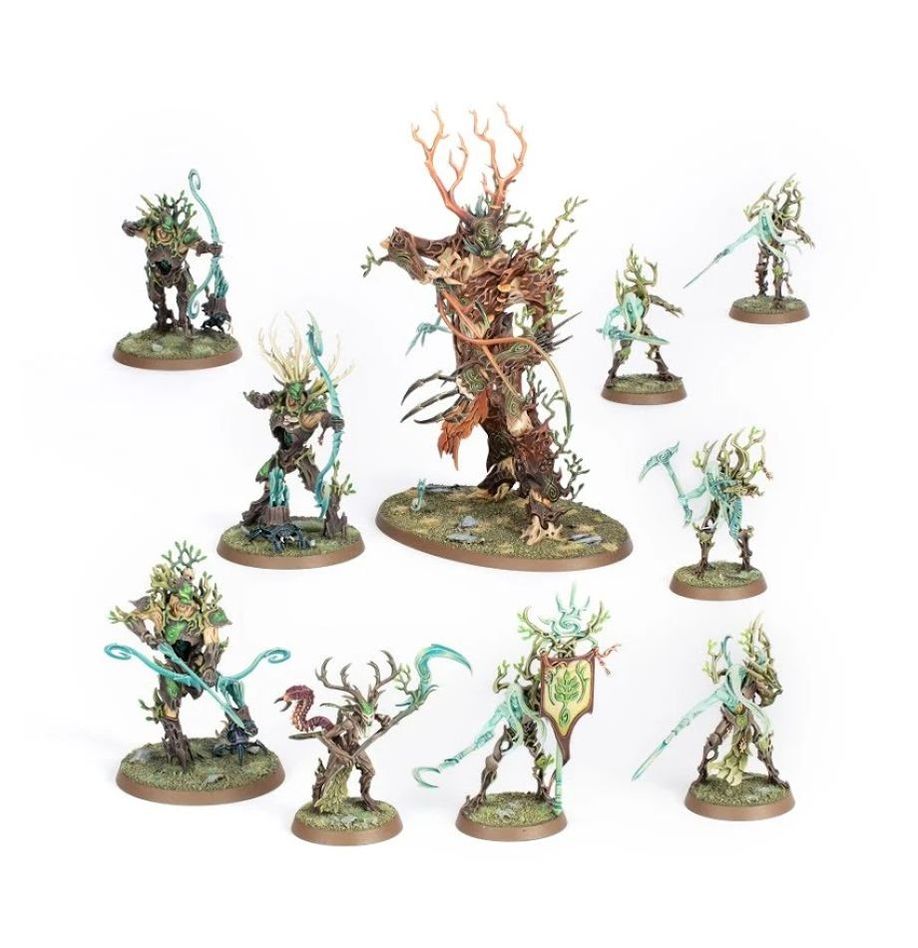
The Sylvaneth Spearhead makes use of the terrain for tricky play and movement shenanigans in Spearhead. Since every game of Spearhead is going to be using the Spearhead terrain, it’s nice to know that limited terrain won’t be an issue for Sylvaneth to get to use their stuff. After picking battle traits and an enhancement, my armies two main tricks is teleporting between terrain pieces (as long as I’m within 3’ of them) during the movement and at the end of the fight phase on a 2+, as well as an extra healing spell on my Branchwych and armywide healing at the end of my turn. Outside the Treelord, my Sylvaneth aren’t very tough and don’t hit as hard as the other Spearhead boxes I played against, but being able to move all over the board in a game focused heavily on objectives is amazing for scoring and getting out of dodge in a tight spot.
I played two games of Spearhead, one against Ossiarch Bonereapers and the other against Seraphon. It’s late after a very full day of Warhammer, I’m running on fumes for these games so I get beat silly in both matches. Which is fine; I only wish that I’d been more alert and played better to feel what other Spearheads are capable of. The Ossiarch match I was sorta getting the hang of the game by the end, but in the Seraphon match they got right up in my grill real quick, all my tree elves were out of place, and I didnt have the brainpower to make it better.
Which means I really don’t have great battle reports to talk about here for Spearhead besides “this event needed a Glass Joe, and by Sigmar I am that bozo.”
What Stood Out about Spearhead
I do have a few notes here about the system that are worth sharing, from learning the rules and my two games of it.
- It is genuinely hard to be tabled or completely out of a match in Spearhead thanks to the reinforcements mechanic and some armies getting guys later in the game. If I’d been smarter, I could’ve put some terrain near my own board edge and planned to arrive from reinforcements with my Tree-Revenants (the Sylvaneth’s only reinforcement unit) nearby. From there, they could easily teleport away, take objectives and do battle tactics. Plus, the command abilities attached to the battle tactics are genuinely very powerful, like being able to pop a 5+ ward on my Treelord when Tim Treebow got charged by a Carnasaur. It’s a really compelling design choice, and I will make the battle tactic system in Spearhead very engaging. The underdog mechanics provided by the twist cards drawn every turn also do a great job at keeping both players in the game.

Credit: Games Workshop - It really is an objective based game. Each side of the board represents a different realm, either Ghyran or Aqshy, and has different twist cards associated with it as well as different objective layouts. The winner of the roll off to start the game can pick which player decided on which side to use, and at higher levels of play I can see some armies favoring one layout over the other.
- From turn to turn, the most important thing to do in Spearhead is take objectives and do tactics cards. Even with the double turn, killing all your opponents models really isn’t a great strategy to win. All objectives in Spearhead are sticky, which is nice with such low model counts, but it also means a canny opponent can steal an objective that you’ve carelessly walked off of. There’s some really clever and interesting play to be had here, and it makes me want to learn more about how other Spearhead boxes play.

Credit: Games Workshop - I got the impression that the team did a good job making each force feel unique. The three factions I had experience with, my own Sylvaneth as well as my Ossiarch and Seraphon opponents, all played unique from one another. Ossiarch have their special Ossiarch command stuff, and the Kavalos Deathriders make for a wicked flank while the Mortek and Harvester hold the line, supported by the Soulreaper. Only one squad of Mortek deploy on the table in Spearhead; the other waits in reserves until later in the game. If you can use the healing mechanics going long enough on your Mortek and Kavalos, Ossiarch’s got nasty flanking potential.
The Seraphon I got less of a solid impression about, besides the fact they’re tough, hit hard, and bite you. That’s not to say there aren’t more nasty tricks to Seraphon; it’s more to say both my opponent and I were very tired at this point and I don’t think we had the brainpower to really see what made Seraphon tick. (Fortunately, Kevin played Seraphon at this event, so he can tell you all about how they play later in the article!)
I elected to not play on day two of the event; a lunch mishap meant that all I had eaten since breakfast was just some lunch meat and cheese. I wasn’t going to be able to survive a second marathon day of Warhammer, so I took my exit with grace and wolfed down a cheeseburger with my friends.
After trying Spearhead, I’m pumped for more. Games Workshop has consistently run into the problem that small points games to try and rope in friends to the hobby actually suck. They aren’t engaging; you just kinda kill each other. Combat Patrol has tried to address this, but it still feels like baby 40k. With Spearhead, they’ve finally done it. A starter box version of the game that will be fun and engaging for both veterans and new players. I think it does have legs to be played at events too, not just as a thing to do between rounds to kill time but as its own ticketed thing for dedicated Spearhead players to enjoy.
Just give me some time for dinner next time, please. I’m so hungry.
Contemptor Kevin
This past weekend I had an opportunity to try out Spearhead, a game mode of the Age of Sigmar fourth edition. This was my introduction to actually playing Age of Sigmar, as I have only been a 40K player.
Spearhead is probably one of the most fantastic ideas GW has ever had, and I hope that eleventh edition 40K’s version of Combat Patrol is a similar board game system to Spearhead.
Anyhow:
Setting the Stage
When the Warhammer Events for 2024 went live in February, there was a little-noticed “Sig-Mystery” event which offered a pre-assembled and primed Spearhead box for evening AOS games. As I didn’t play Age of Sigmar, I noticed but chose not to initially purchase a ticket for this event.
Fast forward a couple of months. Bair and I were talking about how much fun a Combat Patrol event would be where you paint and then play a Combat Patrol. I recalled that Dallas had the Sig-Mystery event…and only Dallas had the Sig-Mystery event. It didn’t take much to realize this would be an AOS fourth edition event, and so I decided to give it a go.
The Event
At Dallas, we were told that we would need to either hand in our phones or otherwise keep them secured – GW was adamant about no pictures. We were, however, welcome to take as many notes as we wanted and tell everyone about the experience.
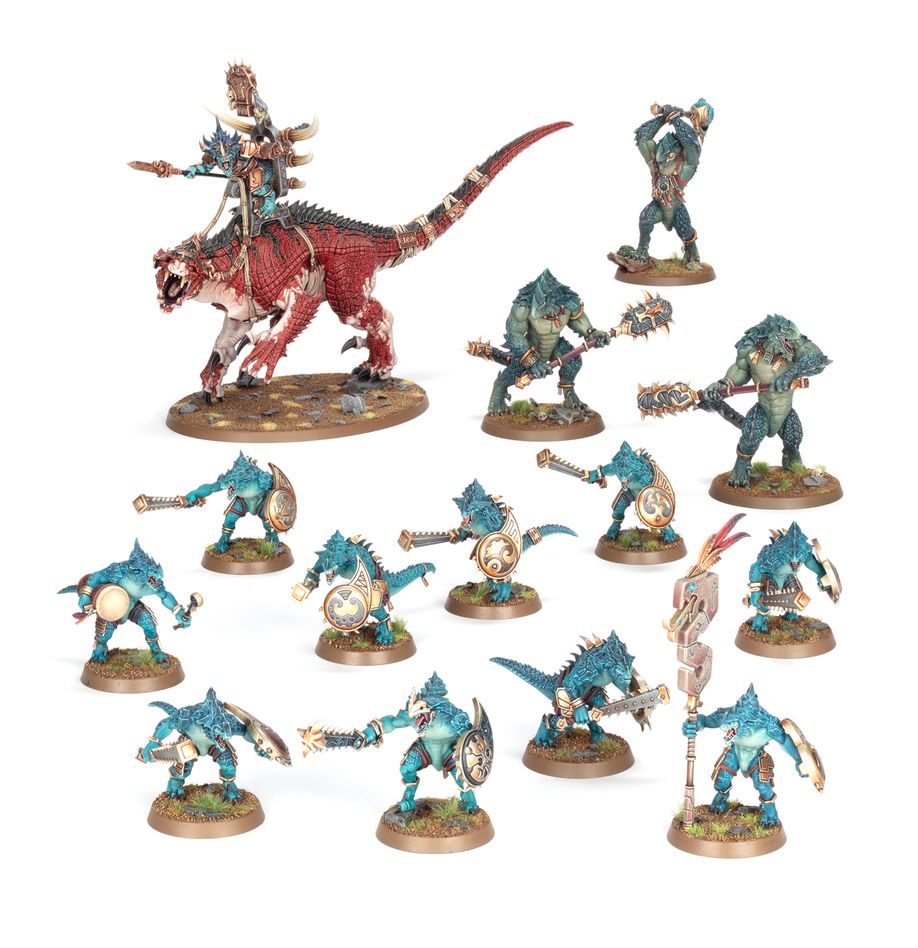
Everyone was seated at a table, where a closed Citadel case sat with a few large pieces of paper underneath them. I popped open my case and found, primed in black, a Seraphon Spearhead! I later learned the Spearheads at the event were:
- Seraphon
- Lumineth
- Nighthaunt
- Sylvaneth
- Gloomspire Gitz
- Warriors of Khorne
- Maggotkin of Nurgle
The Seraphon consisted of four units: The Oldblood on a Carnosaur, 3 Kroxigor, and two units of 5 Saurus Warriors. Each unit had a special ability: The Saurus Warriors could ignore one point of Rend when being attacked on an objective I controlled, the Kroxigor had a Crit (2 hits) when attacking a unit of 5 or more models, and the Oldblood could add 1 to a charge role for the other three. This band of intrepid warriors would go on to fight Nurgle, Khorne, and the Gloomspire Gitz.
The Game and Rules
Spearhead is fought on a relatively tiny board, which means that units that have a 5 inch movement can get around the board quickly. Units that can fly or run can rampage around the board to their heart’s content, blocked only by terrain. This means that yes, you will be fighting on Turn 1.
The initial role is to determine who selects attacker and defender. Defender gets to pick the battlefield and deploy lines (either down the middle or diagonal lengthwise of the board), and if the battlefield is in Aqshy or Ghyran. Both battlefields have the same named/symboled five objectives. The attacker deploys first, and gets to determine which player gets the top of turn 1.
At the top of the round, a “Twist” card is drawn from the deck corresponding to the battlefield. This twist card gives the Underdog player (whomever is behind on the VP count) additional options – for example, they can pick objectives that if they control will give them more VP. I believe there’s some theming between the twists, but I did not have quite enough experience with them.
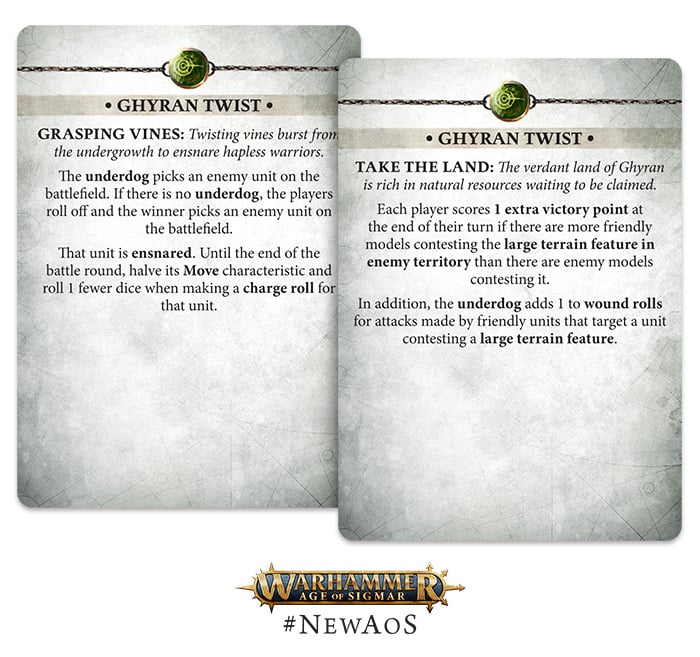
Victory Points are scored at the end of the player’s turn.
Each player draws three tactics card, which have both a secondary objective for the player to complete OR a powerful command ability. A card cannot be used to do both. The secondary objectives are mostly generic, such as “Fight the other players without getting a unit completely destroyed in the fight phase” or “Have a unit wholly within the other player’s side of the battlefield.” Command abilities include “You may retreat without taking mortal wounds” or “Regenerate a unit that has been completely destroyed and put them anywhere more than 6 inches from an opponent.” Tactical cards very much do make or break a game, and getting a hand of tactical objectives you cannot complete on your turn alongside command abilities you can’t use can be a significant blow to your options on your turn.
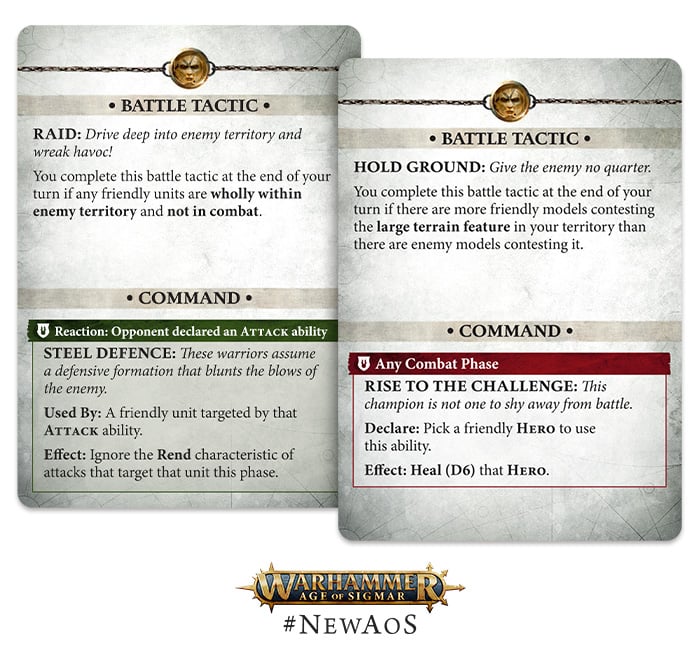
The Double Turn is still present, but taking a double turn prevents the player who took the turn from drawing tactics cards at the beginning of their turn. If they need the double turn in order to complete the three cards in their hands, it can be a powerful strategy.
Most every unit I saw had attacks that would either:
- Hit and Wound on 3+
- Hit on 4+ and Wound on 2+
My Saurus Warriors would hit on 3s and wound on 3s with Rend 1 and most everything had a save of 4+. This meant that the Saurus Warriors could and did kill units with their attacks. The relatively high attack power of the Warriors comes at a cost, though: the Seraphon did not have a way to “naturally” regenerate lost models, like all of their opponents did. Instead, the Seraphon were reliant on using the command abilities on the Tactical Objective cards for regeneration, which meant that a bad draw can leave them in a great deal of trouble. The special ability of the Warriors wants them to hold objectives, so trying to get a jump on their opponents is necessary to win. Because so many attacks in Spearhead have Rend 1, the Warriors generally only had a 5+ save and thus died.
The Games
My first game was against a fellow named Jon, who had a Maggotkin of Nurgle Spearhead. It took us a bit to get started, as some minor maladies with our models required some intervention from GW’s trusty bottle of Gorilla Glue. The rules GW gave us were on large, family restaurant-style menus, which was a bit of struggle to read and absorb while figuring out what to do.
I was the defender for this game, but nonetheless I went first for my first game of Age of Sigmar!
Because I had tactical cards I could achieve during my turn, I let those cards dictate what I did with my units. I chose not to move my Saurus Warriors which were holding one of my objectives, which proved to be a mistake. I jumped out to a somewhat early lead, but lost it by Turn 2 because my Oldblood was killed in Turn 2 and I could not move my second Saurus Warrior Unit around in time before time was called. For a short game, I certainly had a lot of fun!
My second game was against “The” Scott Reid, an extremely affable fellow who despite the late hour was very enthusiastic about his Khorne army. This game was fought on the green side. This game went faster because I was starting to get the hang of my army and the rules in general. Unfortunately for me, I wasn’t able to score any tactical objectives early and could not use the command bonuses. At the end of the game I almost was able to execute a comeback…but then Scott drew tactics cards that let him retreat (for free) and resurrect a unit, taking two objectives in the final turn for the win. It was an extremely exciting game against a wonderful opponent!
After the second game, I returned to my room to begin painting my new Seraphon Spearhead. Twenty hours later, my Spearhead was mostly-finished, based, and ready to play.
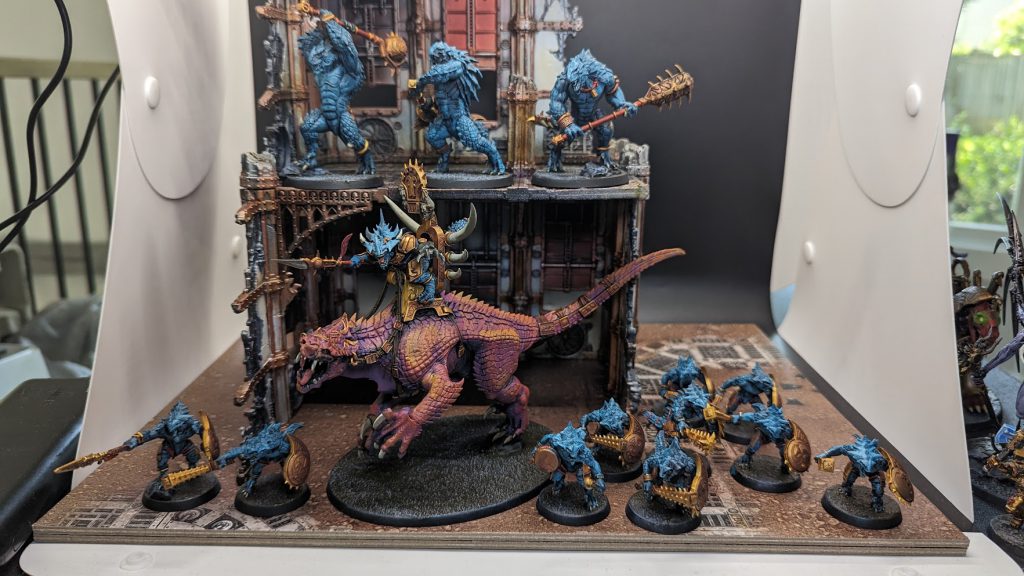
My third game was against a guy named Will who had a Gloomspire Gitz army. This army contained two 5-model Squig Hopper units as well as 2 10-Gob units of Grots. Will went first, and was able to easily send his Squig Hoppers down the board to engage my two units of Saurus Warriors and engage them in combat. His trolls also had a shooting attack, which did some damage to my Kroxigor. Between the Gloomspire model count and initiative, there was no real way for me to recover and I was tabled top of turn 2. Because I had absolutely no sleep because I had spent all night painting my Spearhead, I decided to drop and go back to my room and go to bed.
Conclusion
Spearhead is the perfect introduction to Age of Sigmar, because it is a fun and fast game that is easy to buy into and learn; yet difficult to master. Even if you’re only a 40K only player…find the Age of Sigmar Spearhead that speaks to you, build it, paint it, and play Spearhead. It’s that good. The game offers a lot of tactical depth and both the card draws and dice roll matter; it’s MUCH harder to try and remove variance from the game under this system. I look forward to picking up a few additional Spearheads, as time and my painting schedule allow, and doing different playstyles.

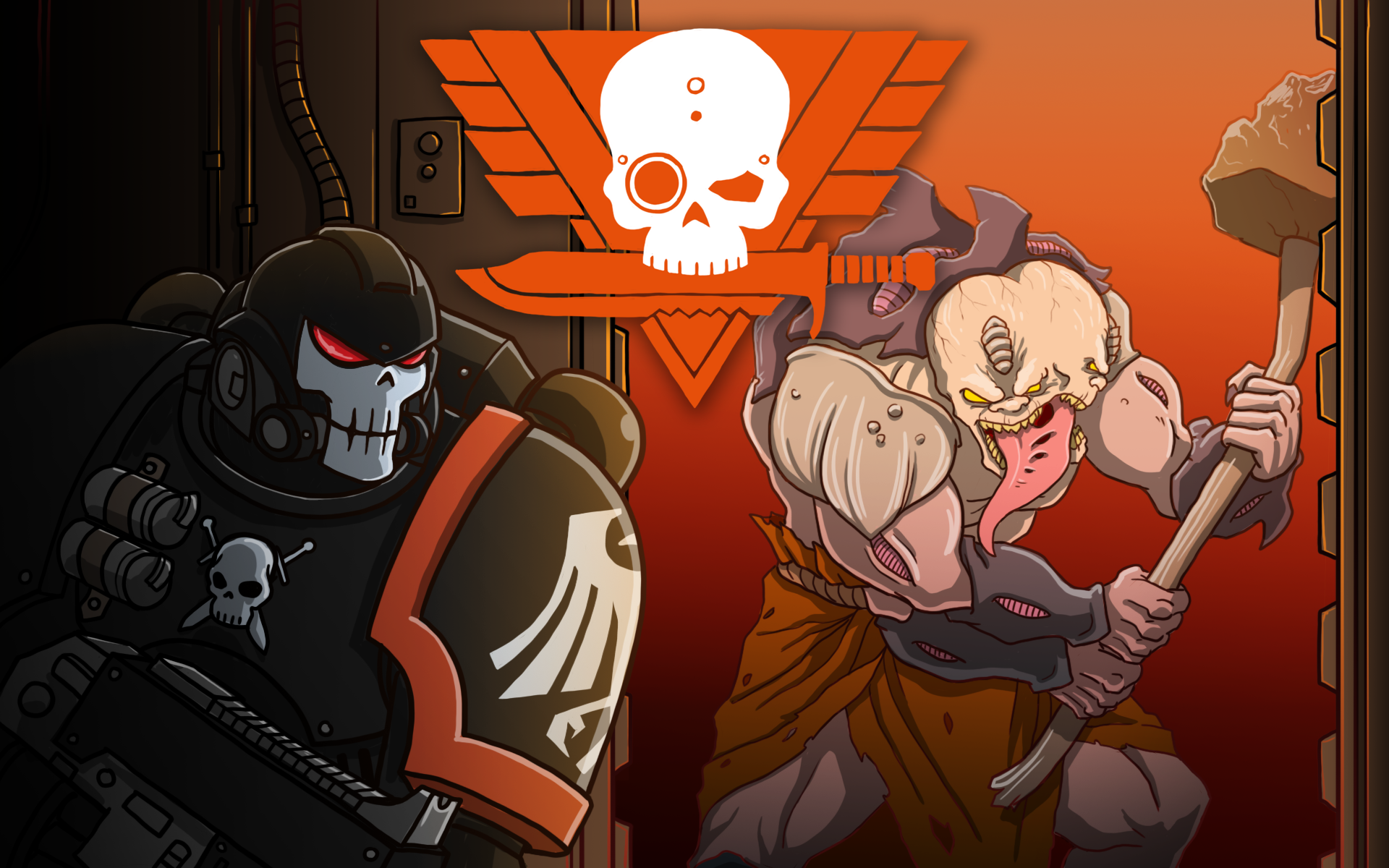


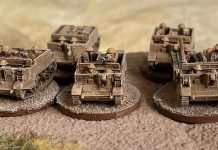
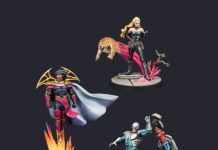



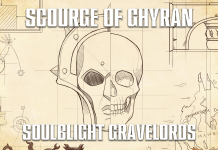
![[40k] Competitive Innovations in 10th: Death Beckons pt.1](https://d1w82usnq70pt2.cloudfront.net/wp-content/uploads/2020/01/Analysis_Banner.png)
